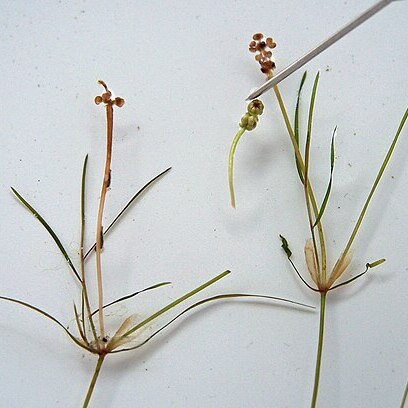Submerged perennial or annual. Stolons absent or present towards the end of the growing season, thread-like, sometimes developing terminal or axillary bulb-like tubers. Stems (1-)4-7.5(-40) cm long, almost terete, ±0.5 mm thick, usually repeatedly branched, sometimes developing terminal or axillary bulb-like tubers. Leaves submerged: stipules axillary, inrolled but free on the inner side, translucent, 5-30 mm long, persistent; leaf blades sessile, linear, flattened, 1.4-8(-13) cm long, 0.3-1(-1.8) mm wide, green to brown, 3-veined, lateral veins indistinct, midrib without gas-filled channels each side or gas-filled channels poorly developed and confined to the basal half of the leaf, bases narrowly wedge-shaped, margins entire, tips acuminate. Peduncles flaccid, flexible, 1-7.5 cm long. Spikes shortly cylindrical, with 3-5 flowers, 3-9 mm long in fruit, contiguous to shortly distant near the base. Drupelets 1 or 2, asymmetrically ovoid, 2.5-3.2 mm long, 1.8-2.1 mm in diameter, the beak 0.3-0.5 long, dorsal keel distinct and often indistinctly toothed.
Small wiry herbs forming dense masses, 50-75 cm high. Rhizome poorly developed or absent. Stems thin, 0.25 mm in diam., grooved, much branched. Leaves all submerged, linear to setaceous, c. 4 cm long and 1 mm broad, translucent, spreading, flat, apex acuminate, midrib prominent, yellowish; stipular sheaths open, deciduous, c. 8 mm long, membranous. Spikes very small, shorter than the leaves, c. 4-flowered, stalk wiry, often curved above; petals with long claws, carpel 1, rarely more, with a large peltate stigma. Drupe ovoid, c. 1 mm long, ventral side nearly straight, beak short, sometimes tuberculate.
Annual, occasionally perennial herb, a dense hydrophyte, height depending on depth of water; rhizome poorly developed or absent; stem thin, grooved, branched. Leaves all submerged, linear to setaceous, 40 x 1 mm, translucent, spreading, apices acuminate, midrib prominent. Spikes small, often curved above; petals with long claws; carpel 1 or rarely more, with large peltate stigma. Flowering time Jan.-? Fruit an ovoid drupe, ventral side ± straight, beak short.
Small, wiry, aquatic herb, up to 0.75 m high. Leaves all submerged; stipules open and tightly inrolled; blade linear, usually 1 mm wide, arising directly from node, flat in transverse section; midrib occupying 30-70% of leaf width. Flowers: in 4-flowered spikes, continuous or sometimes interrupted; peduncles erect, usually emerging above water; Sep.-Feb. Fruit ± 1 mm long.
Small wiry herb, up to 0.75 m high. Leaves all submerged, usually 1 mm wide. Lacunar system bordering midrib not developed or very narrow. Stipule folded. Fruit usually tuberculate and with a basal tooth.
Submerged aquatic forming dense mats. Leaves filiform. Flowers green, inconspicuous.


